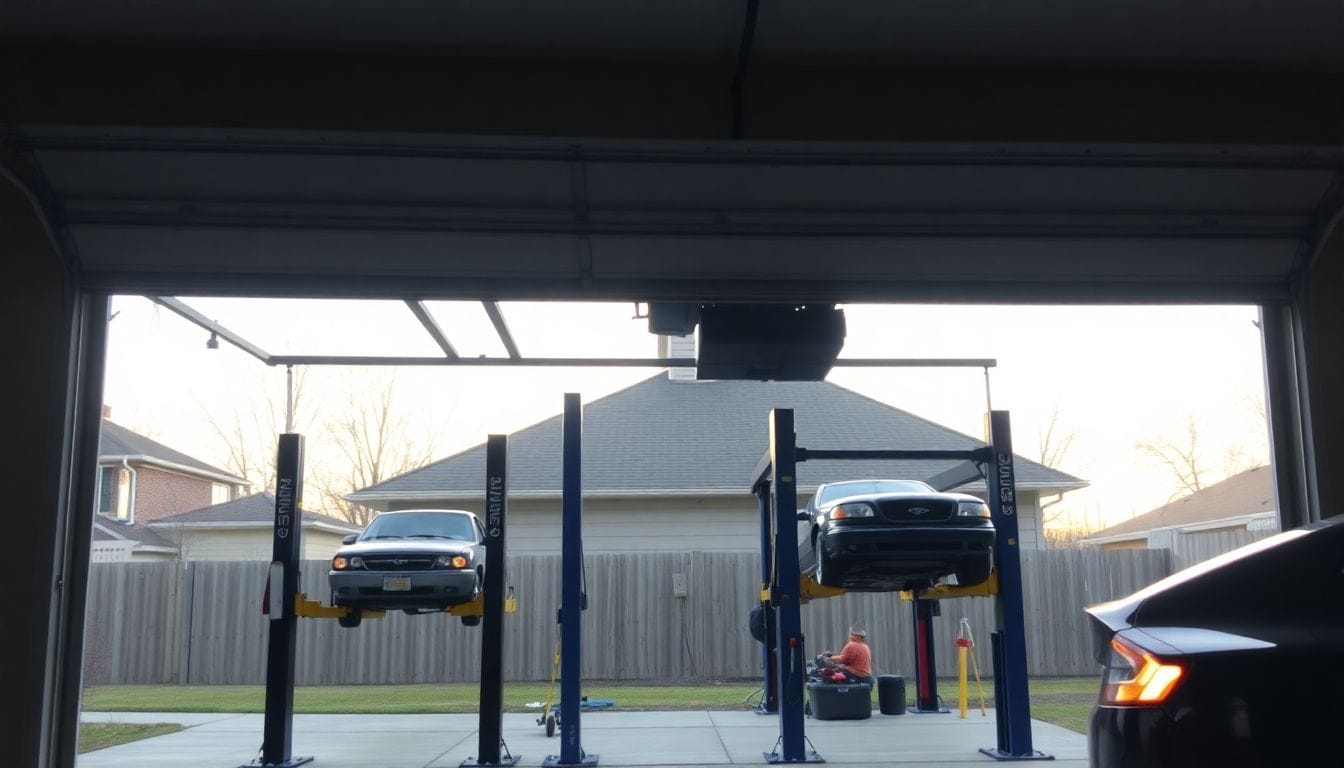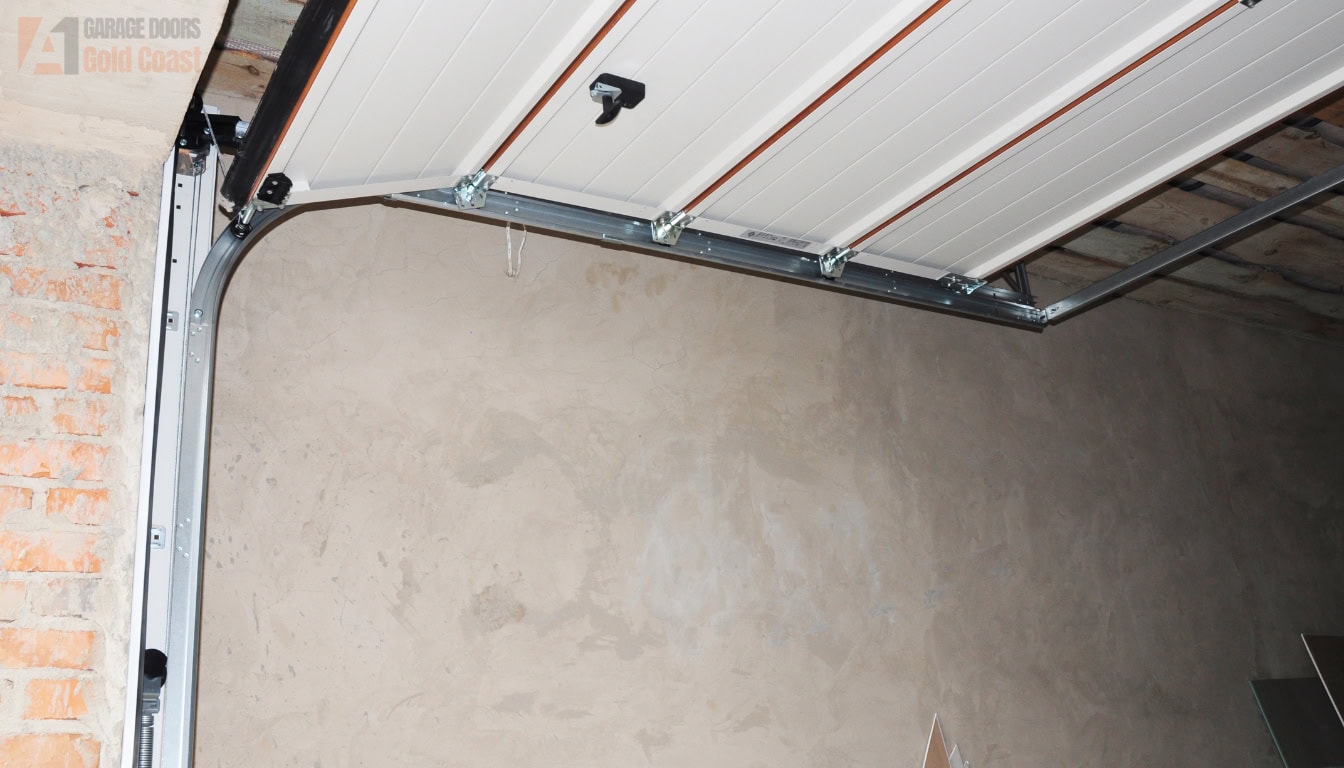Ultimate Guide to Garage Door Lift Mechanisms
Choosing the right garage door lift can be challenging for many homeowners. There are five types of garage door lift mechanisms, each designed for different garage spaces. This guide breaks down each type and explains how to select the best opener for your needs.
Find the perfect garage door solution today.
Key Takeaways
- Five Lift Types: Choose from high lift (adds 12–15 inches), low headroom (requires 5–10 inches), inclined tracks for sloped garages, standard lifts for 10+ inches headroom, and direct drive systems for quiet operation.
- Recommended Openers: Use LiftMaster 8500W for high lift and inclined track setups, LiftMaster 87504-267 for low headroom, and GARAGA Standard+ doors with LiftMaster 8500 for standard lifts.
- Maintenance is Key: Regularly inspect springs and cables, lubricate moving parts, test safety features, check door balance, and tighten hardware to ensure smooth and safe garage door operation.
- Enhance Garage Functionality: Selecting the right lift mechanism improves storage space, energy efficiency with insulated doors, and overall garage accessibility, adding value to your home.
- Professional Support: Schedule annual maintenance with GARAGA dealers or Advantage Garage Doors technicians to prevent major issues and maintain optimal performance.
Types of Garage Door Lift Mechanisms

There are five main types of garage door lift mechanisms. High lift hardware suits garages with high ceilings, adding storage space above the door. Low headroom hardware fits spaces with limited vertical clearance, typically under 10 inches.
Inclined tracks are used for angled garage doors, common in homes with sloped roofs. Standard lift hardware works well for most residential garages with average ceiling heights. Direct drive systems provide quiet and efficient operation by moving the door vertically without extra parts.
Selecting the appropriate lift type enhances both functionality and aesthetics of your garage door.
Understanding these types helps you choose the right garage door opener and hardware for your home.
High Lift Hardware
High lift hardware adds an extra 12 to 15 inches of headroom to your garage door. This upgrade requires specific components, such as longer tracks—typically two feet longer for a 10-foot ceiling and an 8-foot door.
Installing high lift hardware is ideal for garages with high ceilings, offering optimal storage space or allowing for future home gym modifications. Sectional garage doors work well with high lift systems, providing smooth operation and enhanced functionality.
Choosing the right type of garage door lift ensures that your garage meets your storage and accessibility needs effectively.
The LiftMaster 8500W stands out as the recommended opener for high lift setups. It operates quietly, making it perfect for residential garages, and offers smartphone connectivity for convenient control.
High lift hardware is suitable for both attached and detached garages, enhancing the overall garage door opening experience. This system often uses torsion springs to balance the door’s weight, ensuring reliable and safe operation.
Investing in high lift hardware both improves your garage’s functionality and adds value to your home. Upgrading to this type of lift sets the stage for the next steps in maintaining your garage door lift mechanism.
Low Headroom Hardware
Low headroom hardware suits garages with limited space above the door. Front Low Headroom Hardware needs only 7 to 10 inches of headroom, while Rear Low Headroom Lifts require 5 to 7 inches.
These systems work well when replacing old swing doors or fitting into garages with low ceilings, needing just 2 inches of space. The LiftMaster 87504-267 garage door opener is recommended for these setups, providing reliable performance.
This hardware uses double tracks and rollers to prevent obstructions, enhancing safety and functionality. Low headroom options are ideal when other types of lifts aren’t feasible, offering essential garage door hardware for specific building needs.
Although they are typically a last resort, these systems ensure your garage door operates smoothly without requiring extensive space.
Inclined Tracks
Transitioning from low headroom solutions, inclined tracks are essential for garages with cathedral or vaulted ceilings. These tracks follow the roof’s slope, ensuring the sectional door stays flat against the ceiling.
Installing inclined tracks requires a strong torsion spring to support the door’s weight and maintain smooth operation. For optimal performance, the LiftMaster 8500 opener is recommended, providing reliable and efficient door movement.
Standard Lift
A standard lift garage door suits garages with a headroom of 10 inches or more. It typically uses torsion springs, which offer better durability and smoother operation compared to extension springs.
GARAGA Standard+ doors come with an R-16 insulation rating, improving energy efficiency by keeping your home warmer in winter and cooler in summer. Insulated doors help reduce heating and cooling costs, as non-insulated models can lead to higher energy usage.
Selecting the right lift mechanism ensures your garage door operates reliably and lasts longer, providing excellent performance for both single and double garage doors.
Standard lift systems are effective for attached garages and offer ample storage space above the door. They work well with various garage door styles, including traditional and modern designs.
Using a chain drive opener with a standard lift can enhance the door’s functionality, making it easier to open and close. Regular maintenance of the lift mechanism, such as checking the torsion springs and lubricating moving parts, helps maintain optimal performance.
Investing in a quality garage door and lift system ensures safety, efficiency, and convenience for everyday use.
Maintaining Your Garage Door Lift Mechanism
Maintaining your garage door lift mechanism ensures it operates smoothly and lasts longer. Regular upkeep can save you money and prevent unexpected issues.
- Inspect Springs and Cables: Examine the torsion springs and cables for signs of wear or damage. Replace any worn-out parts to maintain door balance and functionality.
- Lubricate Moving Parts: Apply a high-quality garage door lubricant to hinges, rollers, and tracks. This reduces friction and prevents rust, ensuring silent and efficient operation.
- Test Safety Features: Check the auto-reverse and sensor systems regularly. Properly functioning safety features protect your home and family from accidents.
- Check Door Balance: Disconnect the opener and manually lift the door halfway. It should stay in place without assistance. Adjust the springs if the door doesn’t balance correctly.
- Examine the Tracks: Look for bends, cracks, or obstructions in the garage door tracks. Clean and straighten the tracks to allow the door to move freely without impediments.
- Tighten Hardware: Ensure all nuts, bolts, and screws on the door and opener are secure. Tightening loose hardware prevents unnecessary noise and potential damage.
- Update Opener Software: If your garage door opener uses a smart system like the MyQ app, keep the software updated. Updates can enhance security and improve functionality.
- Clean the Door Surface: Remove dirt and debris from the garage door to maintain its appearance and visibility. A clean door also helps sensors detect obstacles accurately.
- Inspect the Remote and Wall Controls: Test all remote controls and wall-mounted switches to ensure they operate correctly. Replace batteries or faulty units as needed to maintain easy access to your garage.
- Schedule Professional Maintenance: Have a GARAGA dealer or Advantage Garage Doors technician inspect your system annually. Professional maintenance can identify and fix issues before they become major problems.
Conclusion
Choosing the right garage door lift mechanism boosts your garage’s efficiency and your home’s value. High lift systems work well where ceiling space is limited, while inclined tracks suit various garage designs.
Keep your lift in good condition for reliable performance. Professional advice can help you select the best opener and hardware. Make informed choices to ensure your garage door operates smoothly for years to come.
For more insights on enhancing your garage door’s functionality, check out our detailed guide on lathe construction for garage doors.
FAQs
1. What are the different types of garage door lifts available?
There are several types of garage door lifts, including torsion and extension spring mechanisms. Torsion systems use a steel shaft with springs mounted above the door, providing smooth and quiet operation. Extension springs are located beside the door and stretch to lift it. High lift garage doors are also available for garages with higher ceilings, offering additional vertical space inside.
2. How does horsepower affect garage door openers?
Horsepower in garage door openers determines the motor’s strength. A higher horsepower opener, such as a 1.5HP or 2HP model, is suitable for larger doors or heavy materials like wood or glass. Choosing the right horsepower ensures efficient door opening and closing, especially for single garage doors or those with additional features like arch designs.
3. Can I convert my carport into a garage using different lift mechanisms?
Yes, transforming your carport into a garage involves selecting the appropriate lift mechanism and garage door type. Overhead door systems are popular for this conversion, offering various styles such as traditional, carriage, or California all-glass garage doors. Ensuring proper installation of the lift mechanism will provide reliable access and enhance the overall functionality of your new garage space.
4. What maintenance is required for torsion and extension spring garage door lifts?
Torsion and extension spring mechanisms require regular maintenance to ensure safety and longevity. For torsion systems, it is essential to inspect the springs for signs of wear and lubricate the moving parts. Extension springs should be checked for proper tension and any signs of rust or damage. Additionally, keep the garage door openers clean and test the door’s balance to prevent excessive strain on the lift mechanism.
5. Are electric garage door openers safe to use in every home?
Electric garage door openers are generally safe for most homes when properly installed and maintained. They provide reliable access to the garage and can be integrated with safety features like auto-reverse and motion sensors. It is important to follow the manufacturer’s guidelines and ensure that the opener meets safety standards. Regular inspections can help identify any issues, ensuring the system operates smoothly without compromising safety.
6. How do high lift garage doors improve garage space and functionality?
High lift garage doors are designed to maximise vertical space, making them ideal for garages with limited horizontal space. By lifting the door higher, they create more storage space above the garage door, which can be used for storing items or installing additional features like bay windows or vertical-lite panoramic windows. This design enhances the overall functionality and resale value of your home, providing a practical solution for efficient space utilisation.
Professional Garage Door Repair Near You
Experiencing garage door issues? Call Reece at (07) 5515 0277 for professional repair. Visit us today for expert assistance and quality service!


